<< Previous | Displaying results 4926-4950 of 6769 for "" | Next >>
Lieutenant General (later Field Marshal) Erwin Rommel commanded German forces during the campaign in North Africa. Libya, 1941.
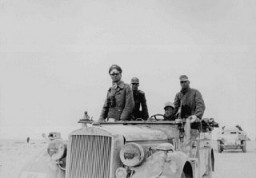
General Bernard L. Montgomery, commander of British forces in Egypt, watches British tanks move toward German lines during the military campaign in North Africa. November 1942.

Generals Dwight D. Eisenhower and George S. Patton discuss Allied military operations in North Africa. Djebel Kouif, Algeria, March 16, 1943.
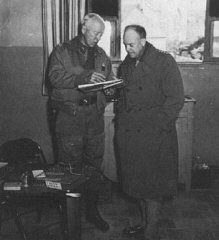
Allied troops board amphibious assault boats off the Algerian coast during Operation Torch. North Africa, November 1942.
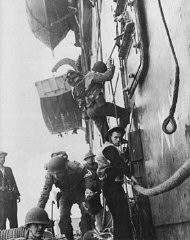
Allied troops march in Tunis following Allied success against Axis forces in the African Campaign. Tunis, Tunisia, May 20, 1943.
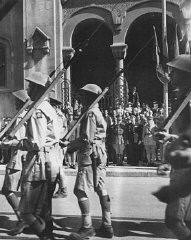
Stephen S. Wise, later to become president of the World Jewish Congress, speaks at an anti-Nazi rally at Madison Square Garden. New York, United States, March 27, 1933.
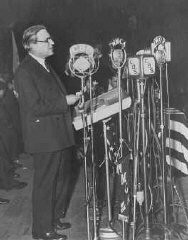
Nazi official Julius Streicher, founder of the antisemitic newspaper Der Stuermer (The Attacker) and organizer of the anti-Jewish boycott. Germany, date uncertain.
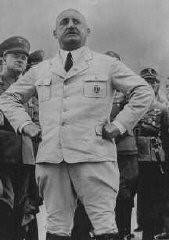
Nazi district leader of Franconia Julius Streicher (right), propaganda minister Joseph Goebbels (second from right), and other Nazi officials attend the opening of the exhibition Der ewige Jude (The Eternal Jew). Munich, Germany, November 8, 1937.
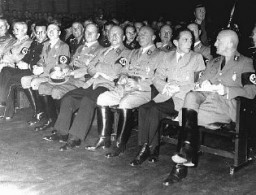
A German couple reads an outdoor display of the antisemitic newspaper Der Stürmer (The Attacker). Germany, 1935.
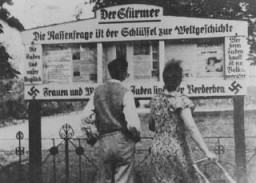
Page of Der Stürmer (The Attacker), a viciously anti-Jewish newspaper published by Julius Streicher. The illustration is an antisemitic photomontage, Germany, 1939. This image was presented as evidence at the Nuremberg trials.
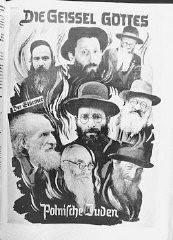
Scene from a Romani (Gypsy) camp: Roma (Gypsies) in front of their tents. Romania, 1936–40. (Bundesarchiv inventory number 146-2001-16-20A.)
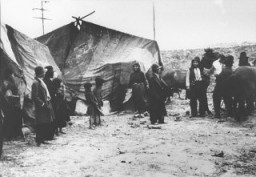
Romani (Gypsy) women boil laundry and hang it to dry in the middle of the camp at Marzahn. Germany, June 1936. Shortly before the opening of the 1936 Olympic Games in Berlin, the police ordered the arrest and forcible relocation of all Roma in Greater Berlin to Marzahn, an open field located near a cemetery and sewage dump in eastern Berlin. Police surrounded all Romani encampments and transported the inhabitants and their wagons to Marzahn.
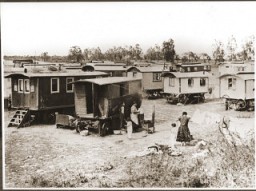
A man works outside his family's dwelling in a Roma (Gypsy) encampment in the city of Haarlem. The Netherlands, October–November 1940.
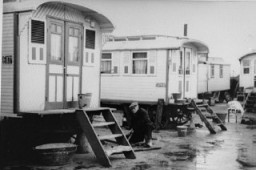
Romani (Gypsy) women march to work in the Lackenbach internment camp. Lackenbach, Austria, 1940-1941.
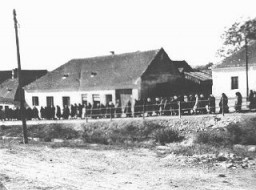
A group of Romani (Gypsy) prisoners in Belzec labor camp, 1940. The Belzec labor camp and its subsidiaries were dismantled at the end of 1940.
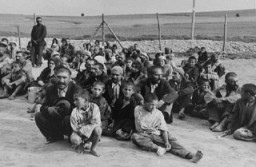
German police guard a group of Roma (Gypsies) who have been rounded up for deportation to Poland. Germany, 1940–45.
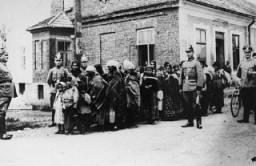
Romani (Gypsy) children play outside at the Jargeau internment camp. The camp was established in response to a German order in October 1940 calling for the arrest and confinement in camps of all Frenchmen or foreigners in the Loiret region who did not have a permanent residence. Jargeau, France, 1941–45. Conditions in the camp were extremely poor and the lack of sanitation facilities led to the periodic outbreak of epidemics.
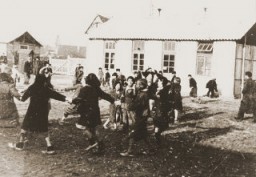
Roma (Gypsies) remove bodies from the Iasi-Calarasi death train during its stop in Tirgu-Frumos. Two trains left Iasi on June 30, 1941, bearing survivors of the pogrom that took place in Iasi on June 28-29. Hundreds of Jews died on the transports aboard crowded, unventilated freight cars in the heat of summer. Romania, July 1, 1941.
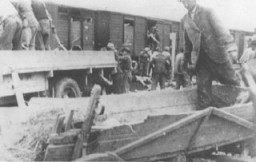
A Serbian gendarme serving the Serbian puppet government led by Milan Nedić escorts a group of Roma (Gypsies) to their execution. Yugoslavia, ca. 1941–1943.
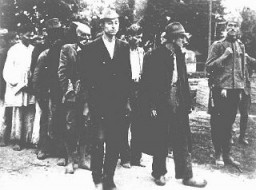
View of the entrance to the "Gypsy camp" on Brzezinska Street in the Lodz ghetto in occupied Poland. Photograph taken in 1942.
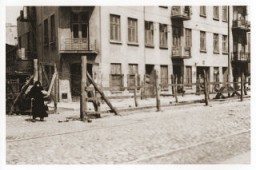
German naval officer Martin Niemöller (top, foreground) commands a U-Boat during World War I. Flensburg, Germany , ca. 1914–17.

Pastor Martin Niemöller at his desk in his home. Berlin, Germany, ca. 1936.
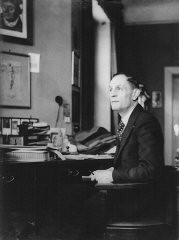
Quotation from Martin Niemöller on display in the Permanent Exhibition of the United States Holocaust Memorial Museum. Niemöller was a Lutheran minister and early Nazi supporter who was later imprisoned in the camp system for opposing Hitler's regime. First they came for the Socialists, and I did not speak out-Because I was not a Socialist.Then they came for the Trade Unionists, and I did not speak out-Because I was not a Trade Unionist.Then they came for the Jews, and I did not speak out-Because I was…
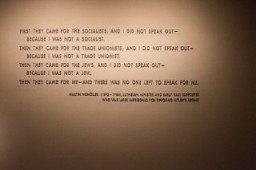
A visitor stands in front of the quotation from Martin Niemöller that is on display in the Permanent Exhibition of the United States Holocaust Memorial Museum. Niemöller was a Lutheran minister and early Nazi supporter who was later imprisoned for opposing Hitler's regime.
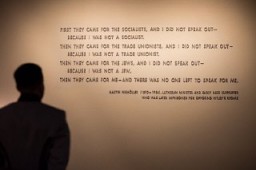
Visitors stand in front of the quotation from Martin Niemöller that is on display in the Permanent Exhibition of the United States Holocaust Memorial Museum. Niemöller was a Lutheran minister and early Nazi supporter who was later imprisoned for opposing Hitler's regime.
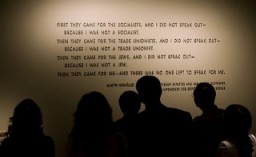
We would like to thank Crown Family Philanthropies, Abe and Ida Cooper Foundation, the Claims Conference, EVZ, and BMF for supporting the ongoing work to create content and resources for the Holocaust Encyclopedia. View the list of donor acknowledgement.